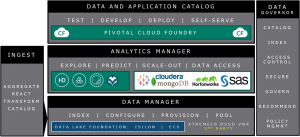Adoption of Hadoop, a low-cost open source platform used for processing and storing massive amounts of data, has exploded by almost 60 percent in the last two years alone according to Gartner. One primary use case for Hadoop is as a data lake – a vast store of raw, minimally processed data.
But, in many ways, because of the perceived lack of governance and security, it's still like the wild west in the Hadoop world, where gunslingers and tumbleweeds abound. In fact, the same Gartner report identified the top challenges to big data adoption as:
- Deriving business value.
- Security and governance.
- Data integration.
- Skills.
- Integrating with existing infrastructure.
Consequently, customers struggle with three main issues: 1) How to start their big data initiatives, 2) How to build out the infrastructure, and 3) How to run, manage, and scale out their solution?
SAS and EMC Deliver Analytic Modernization
To bring order to the wild world of big data, SAS and EMC have partnered to meet customer challenges and deliver a modern analytic architecture. This unified approach encompasses big data management, analytics discovery and deployment via end-to-end solutions that solve your big data problems. They are also designed to free up more time for innovation, deliver faster deployments, and help you find new insights from secure and properly managed data.
The Federation Business Data Lake is a fully-engineered, enterprise-grade data lake built on a foundation of core data federation technologies. It provides pre-configured building blocks that enable self-service, end-to-end integration, management and provisioning of the entire big data environment. Major benefits include the ability to make more timely and informed business decisions and realize the vision of analytics in weeks instead of months.

How does SAS complement the Federation Business Data Lake?
SAS brings a comprehensive analytics platform that provides data access, data integration, data virtualization, and data discovery capabilities and allows you to build, deploy and manage analytic models. This environment is integrated and optimized to run on the Federation Business Data Lake.
Working with EMC, we have defined simple steps to get started on your journey to quickly gain insight and glean value from big data. This includes SAS Data Loader for Hadoop, which provides self-service data preparation, data integration and data quality for business users without writing code, as well as SAS Visual Analytics, which enables you to identify patterns and relationships in data that weren’t initially evident. You can also easily recognize parameters in your data that are highly correlated so you can discover trends within your business that can affect your bottom line.
SAS provides superior breadth and depth of analytics for the Federation Business Data Lake to tackle any big data analytics problem an organization might have, whether it's fraud detection, risk management, customer intelligence, predictive assets maintenance and others. SAS and EMC work together to deliver a robust and comprehensive big data solution with reduced risk, automated provisioning and configuration and is purpose-built for big data analytics workloads.
To learn more, visit the EMC and SAS partnership web page. Or listen to the Federation Business Data Lake virtual launch event.
